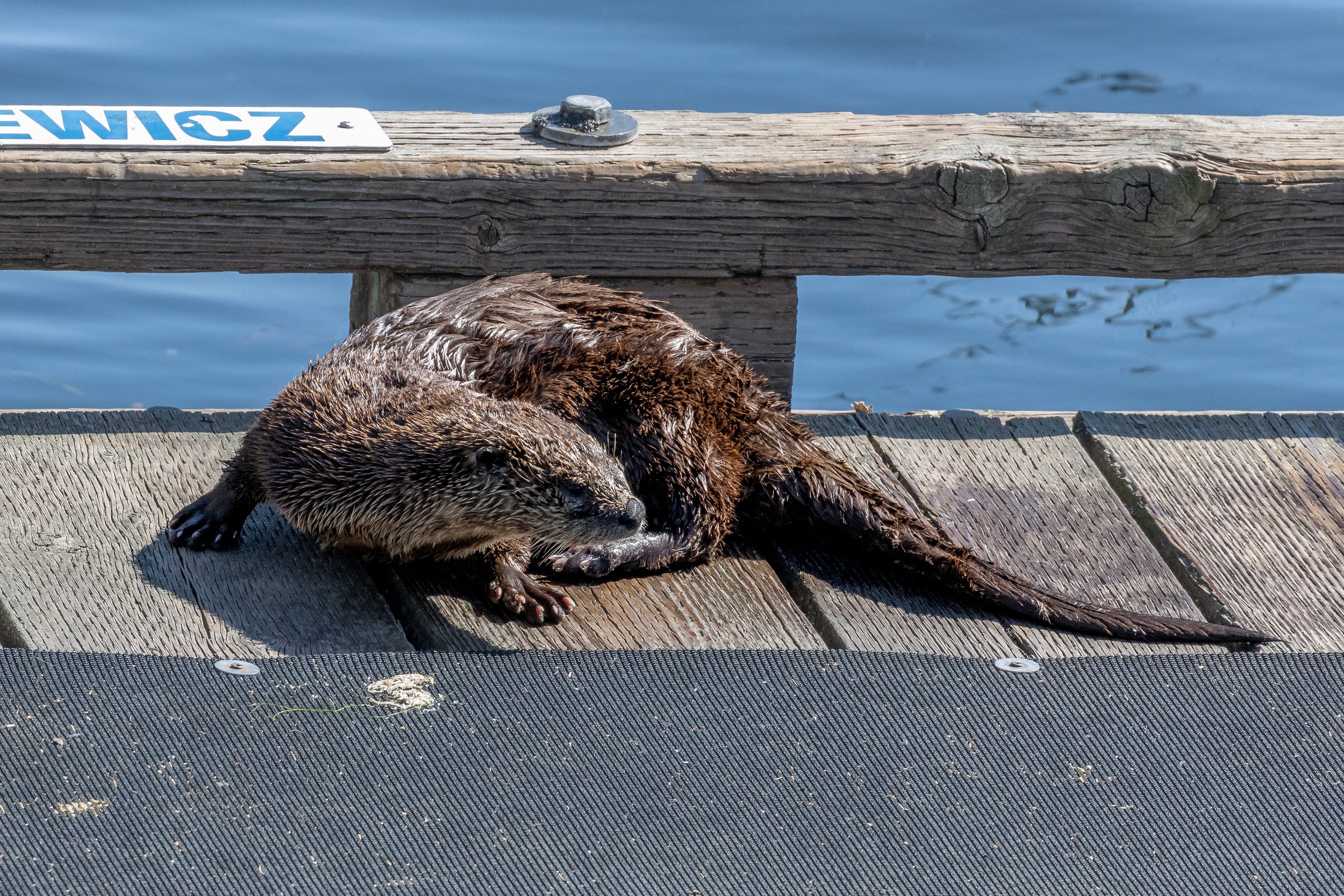June 4, 2023 - T023s in the Southern Gulf Islands
Today’s trip began with reports of rough seas in the Strait of Georgia, so with that, we headed south through rippling and swirling Dodd narrows to sheltered waters in the Gulf Islands. We took this same passage both morning and afternoon as the winds kept blowing in the open waters of the Strait. The morning tour took us into Stuart Channel and then into Trincomali, where we travelled all the way down to beautiful Salt Spring Island. Just east of Ganges is where we encountered our Orca travelling south. This pod was the T023s consisting of the matriarch Janice (T023), her daughter Axle (T023D) and her 3 kids, Robin (T023D3), Sixx (T023D4) and T023D5. In the afternoon we headed back out to find the T023s again. Through Dodd Narrows, down Stuart Channel this time we went into the gorgeous Sansum Narrows, around the corner into Cowichan Bay we found the T023s on the hunt. We knew it was successful when the Gulls and Eagles dived down for some easy pickings after the Orca did all the hard work.
T023 Janice ♀ (≤1964)
T023D Axle ♀ (1993)
T023D3 Robin ♂ (2012)
T023D4 Sixx (2015)
T023D5 (2019)
The Orca we watch on our tours are the Transient or Biggs (named after the scientist Micheal Biggs), these are the mammal hunters. Like wolves of the sea, the Orca will move silently and stealthily through the water in search of prey. Each Orca needs to eat around 300 pounds of food per day, so it’s safe to assume that they are hunting when not travelling or socializing. The majority of our Transients’ diets are made up of the Harbour Seals, so for this family that’s roughly 10 per day! Stellar Sea Lions, California Sea Lions, Harbour Porpoise, Dolphins and even the larger whales are preyed upon by the Transients as well. However, there has never been a successful hunt documented involving one of the Humpback Whales in our waters, we believe this is due to the fact that the young have grown by the time they arrive from their breeding grounds. In October of 2022, there was a hunt that ended in success for two pods of Transient Orca involving a Minke Whale. As unfortunate as this may sound it is the circle of life and in there is no good no bad just nature. Most of the hunt happens below the surface as did this one, so we are not sure what was on the menu today.
We were also witness to a Bald Eagle feeding its Eaglet in the nest, we could tell that they were feeding on an American Coote by its distinct feet that were visible to us in the photos. An adult Bald Eagle needs to eat around 0.5 to 1 pound of food per day, and the Eaglets are fed between 1 to 8 times per day. The busy parents carry prey to the nest and rip off pieces then hold them to the beaks of the Eaglets. The adult Eagles are able to store and soften food in their crops, a part of their esophagus that expands, they are able to store up to 2 pounds of food. However, the adult Eagles do not regurgitate food for their young like most birds instead the torn-up pieces are swallowed whole by the Eaglet. Eagles typically lay between 1 to 3 eggs which take around 35 days to hatch, once hatched the young remain in the nest for 10 to 12 weeks. At the beginning of the Eagles life, it is mostly the male that does the majority of the hunting and feeding, but the female will likely aid the male after the first couple of weeks. The largest Eaglet in the nest will be given priority over the smaller ones and therefore is the most likely to survive. Keep an eye on our future blogs to watch the Eaglets grow up!
Today’s photos were taken by Marine Naturalists Vanessa Vereschahen and Aly Kohlman.
T023 Janice. Photo by Aly Kohlman, 10:30.
T023D3 Robin. Photo by Aly Kohlman, 10:30.
T023 Janice behind T023D3 Robin, can you see Janice’s missing dorsal chunk? Photo by Aly Kohlman, 10:30.
T023D3 Robin. Photo by Aly Kohlman, 10:30.
T023D3 Robin. Photo by Aly Kohlman, 10:30.
T023D Axle. Photo by Vanessa Vereschahen, 3:30.
Left to right: T023D5 and T023D3 Robin. Photo by Vanessa Vereschahen, 3:30.
T023D3 Robin, T023 Janice, and T023D Axle! Photo by Vanessa Vereschahen, 3:30.
T023D3 Robin. Photo by Vanessa Vereschahen, 3:30.
T023D Axle. Photo by Vanessa Vereschahen, 3:30.
T023D5, T023D Axle, and T023D4 Sixx. Photo by Vanessa Vereschahen, 3:30.
T023D3 Robin and T023D Axle. Photo by Vanessa Vereschahen, 3:30.
T023D5 and T023D Axle. Photo by Vanessa Vereschahen, 3:30.
T023D5 and T023D Axle. Photo by Vanessa Vereschahen, 3:30.
Photo by Vanessa Vereschahen, 3:30.
Pooping gull. Photo by Vanessa Vereschahen, 3:30.
A River Otter on the docks! Photo by Aly Kohlman, 10:30.
Did you know that River Otters have 4 nipples? Photo by Aly Kohlman, 10:30.
We think this river otter might be pregnant! Photo by Aly Kohlman, 10:30.
Itchy River Otter. Photo by Aly Kohlman, 10:30.
Harbour Seals hauled out. Photo by Aly Kohlman, 10:30.
Seal wearing a kelp necklace. Photo by Aly Kohlman, 10:30.
Harbour Seal. Photo by Aly Kohlman, 10:30.
Adult bald eagle! Photo by Vanessa Vereschahen, 3:30.
Photo by Vanessa Vereschahen, 3:30.
Photo by Vanessa Vereschahen, 3:30.
California Sea Lion. Photo by Vanessa Vereschahen, 3:30.
Look at the little ears on this California Sea Lion! That’s one of the ways to tell seals from sea lions. Seals don’t have external ears! Photo by Vanessa Vereschahen, 3:30.
This baby eagle is getting a coot for lunch! Photo by Vanessa Vereschahen, 3:30.
Yummy coot. Photo by Vanessa Vereschahen, 3:30.
The cormorants on the bluffs. Photo by Vanessa Vereschahen, 3:30.































